HTC One S Review - International and T-Mobile
by Brian Klug on July 17, 2012 9:30 AM ESTWe’ve already seen 1.5 GHz dual core Krait (MSM8960/MSM8260A/MSM8660A) performance before and talked about it in the HTC One X (AT&T) review, and the USA SGS3 review. For the most part, what we see with the HTC One S variants is largely the same as what we saw with a number of other dual core Krait based devices. Recall that MSM8960, MSM8660A, and MSM8260A differ only in baseband and thus what air interfaces are supported. The only big difference between the devices we've seen based on that SoC so far is RAM, and again the HTC One S includes 1 GB of LPDDR2.
If you’re looking for a detailed comparison to the International SGS3 with Exynos 4412, I've finally had a chance to play with one and we will be doing a more direct comparison with Tegra 3, Exynos 4412, and dual core Krait shortly. I've tossed in the numbers from the International SGS3 for comparison already.
For now, however, let's talk about the HTC One S.
JavaScript Performance
Measuring JavaScript performance is just one component of overall web browsing performance, but it’s the most mature in terms of something we can benchmark. Sunspider 0.9.1 is quite possibly the most well known of these JavaScript tests, and a regular staple of our testing suite:
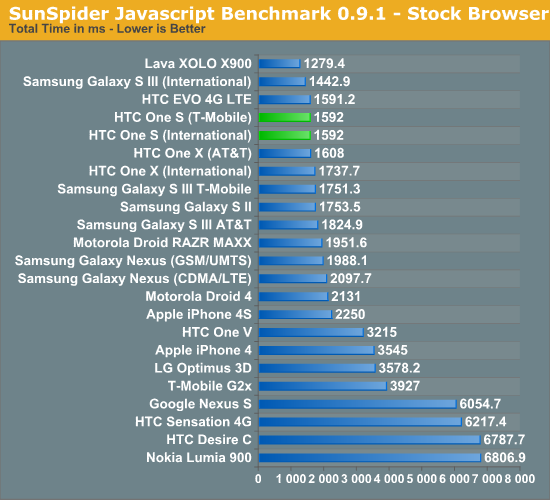
There's an obvious grouping of 1.5 GHz dual core Krait devices around 1500 ms. What spread there is between devices is primarily a function of whatever tweaks OEMs have made to the stock browser's V8 JavaScript engine.
Next up is Browsermark, which is another primarily JavaScript benchmark, with a few other measures. I'm told there are future versions planned which target HTML5 canvas performance.
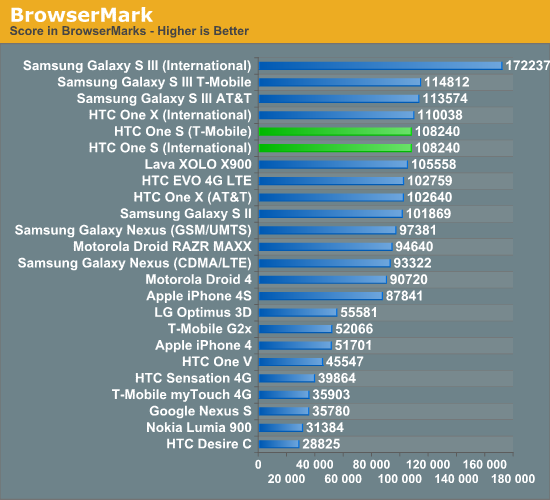
Again there's an obvious clump of dual core Krait devices. The International SGS3 pulls way ahead here for some reason.
Next up is Vellamo, which is a Qualcomm benchmark developed originally for OEMs to use and optimize their browser performance with, and later released for general use. It’s a regular member of our test suite and includes both JavaScript tests and scrolling tests that stress the display composition and hardware acceleration in an Android WebView.

Unsurprisingly the Qualcomm based devices do well in their own benchmark. All of the devices that score above 2000 feel very smooth browsing around in the stock browser and WebView. For the most part, choppy translation and zoom is a thing of the past on Android 4.x.
Low Level FP Performance
Linpack isn’t a great indication of overall smartphone performance, but it is a good test of the floating point capabilities of the CPUs in these SoCs. ARM has steadily been improving FP performance for the past few generations but we’re going to see a big jump to Krait/A15. As most client smartphone workloads are integer based and those that are FP heavy end up relying on the GPU, an advantage here doesn’t tell us much today (particularly because Linpack isn’t running native code but rather atop Dalvik) other than how speedy the FPUs are. There’s a new port of Linpack which runs using native code which we’ll be trying out in the big performance comparison piece.
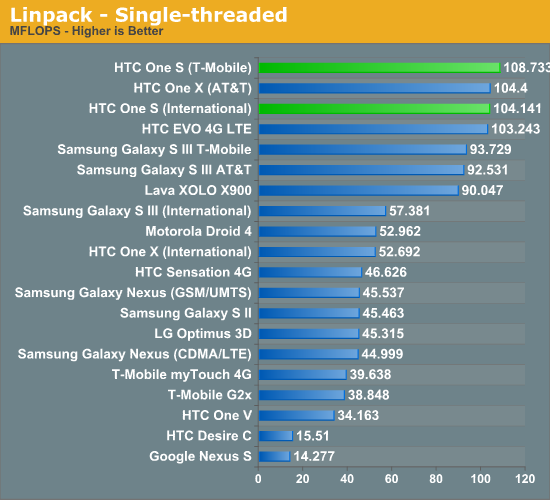
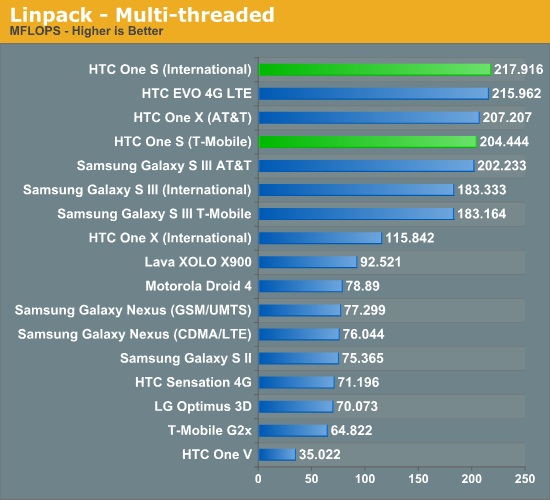
I'm becoming more and more dissatisfied with this GreeneComputing build of Linpack, and given the availability of some alternatives which are implemented natively as opposed to atop Dalvik, will probably move away from it very soon.
BaseMark OS
Rightware’s BaseMark OS is a general purpose benchmark designed to better simulate overall Android performance. It includes a heavily threaded benchmark, file IO tests, and compression/decompression tasks that all contribute to its overall score. This benchmark is pretty much the closest thing we have to a system benchmark for Android at this point, and is very close to achieving the same level of adoption that a few other big industry benchmarks have.
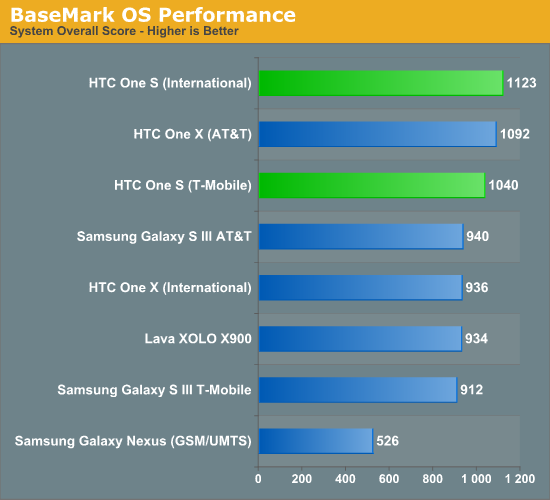
GPU Performance - GLBenchmark 2.1
As we wait for actual 3D gaming benchmarks to make their way into Android (and hopefully cross platform) games, we must rely on synthetic tests designed to simulate 3D game performance as best as possible. We start with GLBenchmark, one of the better Android GPU tests on the market today. There are two benchmarks, Egypt and Pro, and each is run in two modes: native screen resolution and offscreen (vsync disabled) at 720p. The latter is more useful for apples to apples comparisons as everything is rendering the same number of pixels, whereas performance in the onscreen tests is determined by the screen resolution of the device along with the performance of its GPU.
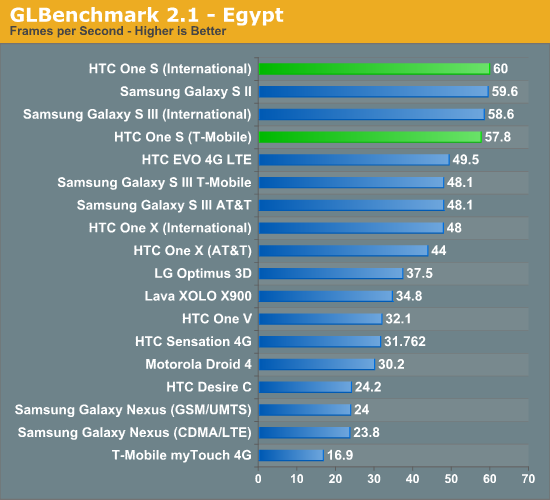

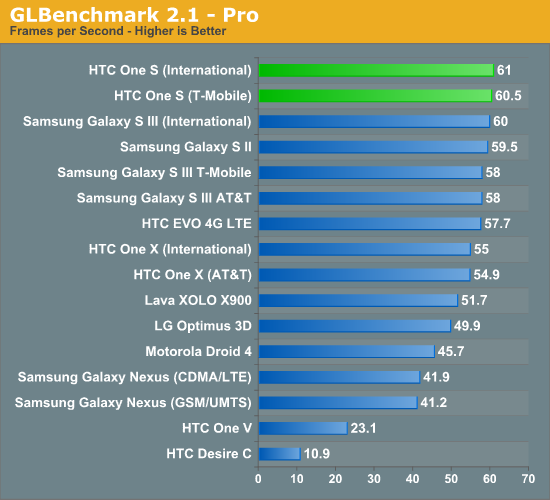
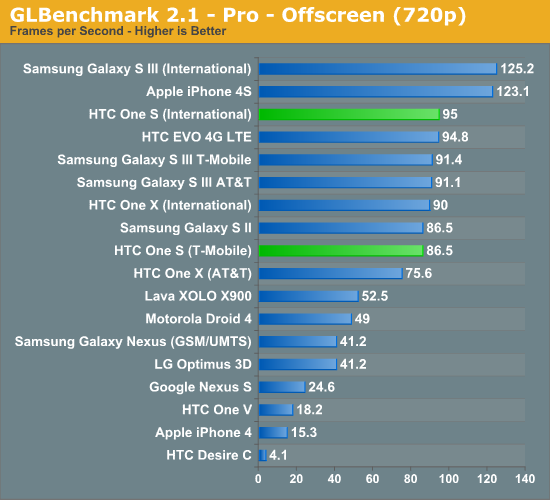
As a reminder, only the offscreen tests take place with vsync turned off, which is why you see devices with 720p displays posting different results on versus off screen where vsync is off. Part of the deal in getting Krait to market as quickly as possible required that Qualcomm pair the CPU with an older GPU, in this case the Adreno 225 instead of the newer Adreno 3xx offerings due out later this year in SoCs like MSM8960 Pro or the quad core Krait APQ8064. As a result, you can see the SGS2 with Exynos 4210 and the SGX543MP2 in the iPhone 4S pull ahead in some tests. Obviously the on-screen test isn’t a totally fair comparison because of the inherent difference in resolution - the One S is qHD.
Basemark ES 2.0 V1
Rightware’s Basemark ES 2.0 V1 is an aging GPU test that tends to favor Qualcomm’s Adreno GPUs above almost all others:
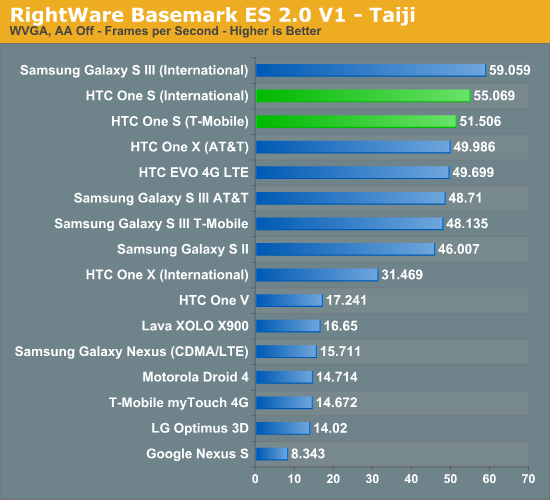
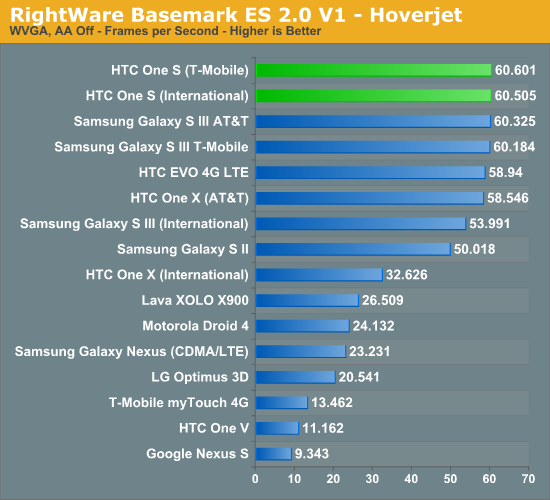
These two tests we run at WVGA on the device. Basemark ES 2.0 is definitely starting to show its age, as Hoverjet is at vsync essentially the whole time, and Taiji is nearly there as well. Qualcomm appears to be using ES 2.0 as an optimization target, so I wouldn’t put too much faith in the ES 2.0 results.










97 Comments
View All Comments
michael2k - Tuesday, July 17, 2012 - link
How is the coming on 10 months old iPhone 4S still getting some of the best battery life?What is going on in Android land?
GrizzledYoungMan - Tuesday, July 17, 2012 - link
Faster processors + LTE.Next.
ltcommanderdata - Tuesday, July 17, 2012 - link
I don't think it's that simple. Yes these recent Android phones have newer, faster Krait SoC which could draw more power compared to the Cortex A9 based Apple A5 in the iPhone 4S, however Krait has the advantage of the latest 28nm process to offset this while the A5 is still on the now more than 3 years old Samsung 45nm process. While the CPU portion of newer SoCs is faster than the A5, the A5's GPU is still faster than the GPUs in every other SoC except the recent Exynos 4412. The A5 is also known to be a large die, high transistor design, which won't do it any favours in reducing power consumption. I don't see a faster processor as being a clear disadvantage to battery life in recent Android phones compared to the iPhone 4S.LTE's contribution also probably isn't huge considering these battery tests are specifically done on 3G and WiFi allowing the LTE portion of the baseband to remain idle and power-gate. While hardware choice contributes, I do think software plays a role since Apple can spend all their time optimizing for one specific hardware configuration whereas Android manufacturers don't really have that luxury.
OCedHrt - Tuesday, July 17, 2012 - link
GPU's are power gated when you're not gaming. A powerful GPU doesn't kill battery life unless all you do is gaming.LTE kills battery life whether you use it or not. Just look at those 4 hour LTE phones from last year. The reason is because the LTE radio is a separate chip - it isn't controlled by the SoC and likely cannot be power gated.
The current generation of 28 nm w/ LTE on chip does have much better battery life - however with Android's multitasking, background syncing, Android simply isn't going to get longer battery life than iPhone 4s unless you turn it all off - and you can turn it off.
Then, as many iPhone 4s users will tell you, many of them also get shitty battery life - it probably depends even more so on how you use it.
amdwilliam1985 - Tuesday, July 17, 2012 - link
"Then, as many iPhone 4s users will tell you, many of them also get shitty battery life - it probably depends even more so on how you use it."Totally agreed, a coworker here with iPhone 4 has battery drained from ~85% to ~55% overnight in "standby" mode.
My SGS2 can go through 2 normal days easily now that I enabled wifi calling and using edge(~10k/s, it's more than enough for texting and syncing).
OCedHrt - Tuesday, July 17, 2012 - link
My One S's wifi calling drains more battery than 3G with strong signal.leexgx - Wednesday, July 18, 2012 - link
what stands out is how can the Motorola Droid RAZR Maxx have such poor web 3G browsing (unless the USA version test was done with LTE then i would cida under stand then) and Wifi Hotspot Battery timethat seems impossible with the 3200mha bat at its disposal i cant see how them results are correct for that phone
what also surprises me is How you manage to get most of these phones to last more then 4-5hrs of constant use (that lacks an secondary Clip on battery like i just got for my HTC One X or an bigger battery like i had for my HTC Desire phone) any phone i see cant seem to last the day of Light use half an day if used in the day unless power is supplied in the day
one thing i hate about the HTC one X an little is Power button really could do with been on the side like the Samsung S3 (phone is to long for 1 hand power button at the top) not sure if its me but phone seems to have been made for Left handed users, the answer and hangup icons have been switched (answer should be on the left and hang up should be on the right) sure that's how my HTC desire had it (guess i should turn on on before i look dumb :) )
other thing as well WiFi and Data go into Forced power saving mode after midnight to about 8am (it turns Wifi off and data Off Even if its Plugged into power after 15 mins screen off, comes back on screen comes on)
OCedHrt - Wednesday, July 18, 2012 - link
I easily get 5+ hours of constant use on my One S. The screen uses up most of the battery, and the on time is always over 5 hours. Sometimes more than 6.name99 - Tuesday, July 17, 2012 - link
Was the coworker using Skype?Skype is notorious for draining the battery rapidly, even while in the background. It's one of the few apps that CAN do so because it's a VoIP app so gets background time (and it basically proves Apple's point that if you allow background apps time, they WILL be written by crappy engineers and they WILL do a crappy job.)
Without wanting to make a big deal about it, I'd point out that under normal circumstances (ie Skype NOT running in the background) my iPhone4 drains by around 5% or less overnight. With Skype running it will drain by 30% or so --- which basically matches what your co-worker was seeing.
OCedHrt - Wednesday, July 18, 2012 - link
Skype is pretty crappy, but there are other, better, VoIP apps available on Android.